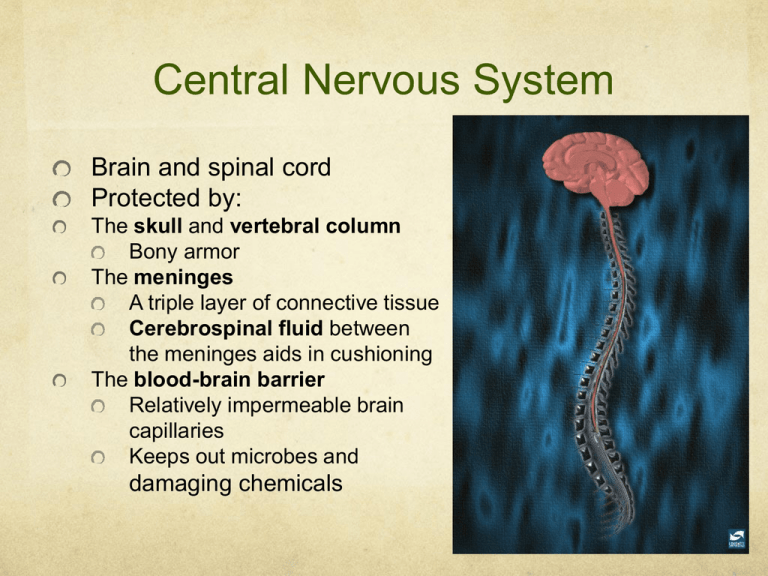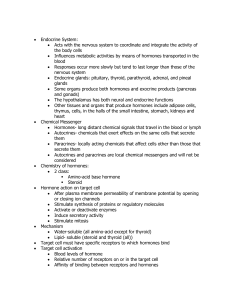Central Nervous System Brain and spinal cord Protected by:
advertisement

Central Nervous System Brain and spinal cord Protected by: The skull and vertebral column Bony armor The meninges A triple layer of connective tissue Cerebrospinal fluid between the meninges aids in cushioning The blood-brain barrier Relatively impermeable brain capillaries Keeps out microbes and damaging chemicals The Spinal Cord Cable of axons protected by the backbone Transmits signals between the brain and body Grey matter Cell bodies of motor and association neurons White matter Surrounds the grey matter Myelinated axons Send impulses up and down the spinal cord The Spinal Cord Neural pathways for some simple behaviors (reflexes) The Vertebrate Brain Major anatomical and functional divisions Hindbrain Midbrain Forebrain These parts develop different sizes in different species The Hindbrain Medulla controls several autonomic functions, such as breathing, heart rate, and blood pressure The pons plays a role in the transition from sleep to wakefulness, and regulates breathing rate Cerebellum helps coordinate movements of the body The Midbrain The reticular formation An important relay and sensory filtering station Extends from medulla into lower regions of the forebrain The Forebrain Thalamus Limbic system Cerebral cortex The Thalamus Channels sensory information from all parts of the body to the limbic system and cerebral cortex The Limbic System Produce our most basic and primitive emotions, drives, and behaviors The hypothalamus is a coordinating center between the nervous and endocrine systems The amygdala produces sensations of pleasure, fear, or sexual arousal The hippocampus is involved in emotional behaviors and the formation of long-term memory The Cerebral Cortex Convoluted outer layer of the forebrain Two hemispheres connected by a large band of axons (the corpus callosum) The Cerebral Cortex Each hemisphere is divided into four anatomical regions Frontal lobe- motor, intellectual functions Parietal lobe- sensory functions Occipital lobe- vision Temporal lobememory, language comprehension, hearing The Cerebral Cortex Each hemisphere is made of different functional areas Primary sensory areas: sensory signals received, impressions are formed Association areas: interpret sounds and link stimuli with memories Primary motor areas: in the frontal lobe; stimulate motor neurons Living things respond to stimuli What senses are these animals using? The Brain interacts with the outside world through senses Sensory receptors transduce the energy of a specific signal into an electrical signal - receptor potential If the receptor potential is positive enough, an action potential forms The more positive the receptor potential, the higher the frequency of action potential formation Sensory Receptors Mechanoreceptors Sense mechanical stimulus- motion, touch, vibration Mechanoreceptors- skin Produce receptor potential when membrane is stretched or dented Free nerve endings produce sensations of itching, tickling, and touch Nerve endings enclosed in connective tissue detect pressure Other mechanoreceptors In hollow organs signal fullness by responding to stretch In joints to sense position of limbs In inner ear to detect gravity, motion, vibration (sound) Fish mechanoreception The lateral line A row of hair cells along the body Senses vibration and water movement Mechanoreception & Sound Sound waves are vibrations in fluid (air, water) Mechanoreception & Sound Outer ear captures sound waves and aids in sound source localization External ear: collects and directs sound waves Auditory canal: carries sound waves to the middle ear Mechanoreception & Sound Middle ear transmits sound waves to the inner ear Tympanic membrane: the eardrum Middle ear bones: transmit sound vibrations to inner ear Auditory tube: equalizes air pressure between the middle ear and atmosphere Mechanoreception & Sound Inner ear converts vibrations into electrical signals Middle ear bones transfer sound energy into the cochlea Vestibular system: involved in balance The Cochlea Vibrations produce fluid movement tranmitted to the basilar membrane Basilar membrane vibrations cause hair cells to bend against the tectorial membrane Receptor potentials are formed, and action potentials are sent to the brain Sound Perception Volume Larger sound vibrations bend hair cells more Very loud or prolonged sounds can damage hair cells Pitch Different parts of the basilar membrane vibrate at different frequencies Photoreception All forms of vision use photoreceptors Cells that contain photopigments that absorb light, which produces chemical changes When photopigments change, receptor potentials form Eyespots Basic light/dark reception Not image forming Compound Eyes Arthropods Many individual light-sensitive subunits - ommatidia Each ommatidium forms a small part of a larger image Pieced together to form a grainy visual mosaic The Mammalian Eye Collects, focuses, and transduces light waves Cornea: transparent covering Aqueous humor: watery fluid; nourishes lens and cornea Sclera: white outer layer; tough connective tissue Iris: pigmented ring of muscle; controls light entry Pupil: opening in the center of the iris The Mammalian Eye Lens: transparent protein structure bends light- focus Vitreous humor: jelly-like fluid; maintains eye shape Retina: multilayered sheet of photoreceptors Choroid: dark middle layer absorbs stray light; blood supply helps nourish retina The Adjustable Lens Muscles attached to lens contract to change the shape Fovea of retina - visual image is focused most sharply Lens allows images to be focused on the fovea when looking at objects at different distances Common vision problems Abnormally long eyeball: the image is focused in front of the retina nearsightedness Abnormally short eyeball: the image is focused behind the retina farsightedness Retinal Photoreceptors Cones- color vision Concentrated in the fovea Require relatively bright light to function Detect red, green, and blue light wavelengths Rods- vision in dim light Concentrated in the periphery of the eyeball Perceive light intensities (shades of grey) Transmitting the signal Signal-processing neurons Process receptor potentials and pass forward impulses Ganglion cells At the front of the retina Carry action potentials to brain along optic nerve The blind spot is where the optic nerve connects to eyeball No photoreceptors, so images disappear Eye placement affects vision Carnivores and omnivores have forward-facing eyes Eyes have overlapping visual fields Allows depth perception (binocular vision), which allows more accurate prey capture Many herbivores have widely spaced eyes Little visual field overlap Near 360-degree field of view Allows for easier predator detection Chemoreception Chemoreceptors detect presence of chemicals in fluids Smell: detecting airborne or waterborne molecules Taste: detecting molecules dissolved in water or saliva Olfactory Receptors Located in the upper nasal cavity Hair-like dendrites protrude into a mucus layer Odorous molecules in air dissolve in nasal cavity mucus and bind to receptors on olfactory dendrites Taste Receptors Contained on tastebuds-about 10,000 on the tongue Each taste bud contains 60-80 taste receptor cells Taste receptor microvilli project out a taste pore Dissolved chemicals enter the pore and bind to receptors on microvilli Taste Receptors Allow the perception of flavors sweet, sour, salty, bitter, and umami Taste receptors are evenly distributed Flavor combines with odor to produce taste Pain Perception of tissue damage Pain receptors respond to two chemical stimuli Potassium ions Bradykinin is formed from enzymes released from damaged tissue Some senses are unfamiliar to humans Echolocation Use of sonar to hunt in darkness or murky waters Bats have large ears and modified middle ear bones Porpoises make ultrasonic clicks that are directed through large, oil-filled sacs Electroreception Used to capture prey Electric fish produce high-frequency electric fields This field is perceived by electroreceptor cells Objects near the field distort it, alerting the fish Sharks use electroreception Ampullae of Lorenzini concentrated on snout Can detect prey from weak bioelectric signal Electroreception Also used in communication Some electric fish can detect and recognize the signals of potential mates Magnetic fields Some animals, such as birds and fish, can use the Earth’s magnetic field to navigate over long distances for migration The Nervous System relies on electric communication The Endocrine System relies on chemical communication Chemical Communication Direct communication from the inside of one cell to the next occurs through gap junctions Cells release “messenger molecules” that stimulate cells if the molecules bind to receptor proteins Like neurotransmitters in the nervous system! Chemical communication Paracrine communication occurs between nearby cells using local hormones that diffuse through extracellular fluid Endocrine communication occurs between distant cells using hormones that are carried by the bloodstream Paracrine communication Local hormones produced by most cells Example: prostaglandins Are modified fatty acids used for local communication Umbilical cord arterial constriction Stimulate uterine contraction Contribute to inflammation Stimulate pain receptors Endocrine Communication Hormones released in response to stimuli Glands make up the endocrine system Travel through the circulatory system to reach target cells Three Classes of Endocrine Hormones Amino acid-based hormones: synthesized from single amino acids Peptide hormones: made from chains of amino acids Steroid hormones: made from cholesterol Endocrine Hormones are Targeted A cell will only be affected if it has receptors specific to that hormone Different classes of hormones bind to receptors in different ways Differences in chemical composition affect ability to penetrate cell membrane Hormone Solubility Water-soluble Most peptide and amino-acid based hormones Cannot penetrate cell membrane Water-soluble hormones use cell membrane receptors Activates formation of a “second messenger” that produces cellular effects Lipid-soluble Steroid hormones Can easily penetrate cell membrane Enter cell and bind to receptors in cytoplasm or nucleus Resulting hormone-receptor complex activates genes Regulation of Hormone Release Most hormones are controlled by negative feedback, which inhibits further release In a few cases, positive feedback is used to amplify hormone release Mammalian Endocrine System There are many animal hormones The major functions of vertebrate hormones are well established (Summarized in Table 37-3, p. 747) Exocrine and Endocrine Glands Exocrine glands: produce secretions that are released through a duct Outside the body, or into body tubes and cavities Endocrine glands: ductless and secrete their hormones within the body Released into interstitial spaces, enter capillaries, and are transported through the circulatory system The Hypothalamus and Pituitary Coordinate many key hormonal messaging systems Hypothalamus controls the pituitary gland The Hypothalamus Clusters of neurosecretary cells Synthesize and store peptide hormones Release when stimulated The Pituitary Dangles below hypothalamus Controls hormone release Anterior pituitary True gland Posterior pituitary Extension of hypothalamus Control of the Anterior Pituitary Hypothalamus hormones regulate release of pituitary hormones Releasing hormones Inhibiting hormones Anterior Pituitary Hormones Regulation of hormone production in other glands: Gonads- production of sperm, eggs, and sex hormones Follicle-stimulating hormone Luteinizing hormone Thyroid Thyroid-stimulating hormone –release of thyroid hormones Adrenal glands Adrenocorticotropic hormone- release of cortisol Anterior Pituitary Hormones Prolactin- development of mammary glands Melanocyte-stimulating hormone- synthesis of melanin Growth hormone- regulates body’s growth Control of the Posterior Pituitary Hormones produced in the hypothalamus Cell bodies in hypothalamus Neurosecretary cell endings in posterior pituitary Posterior Pituitary Hormones Antidiuretic hormone- prevents dehydration Oxytocin- contraction of uterus, milk letdown reflex, pair-bonding in mammals Thyroid Base of neck Metabolism- Thyroxine Calcium levels- Calcitonin Thyroxine Elevates metabolic rate Can also help regulate growth Thyroid Enlargement Low Iodine conditions Thyroid attempts to compensate by increasing number of thyroxine-producing cells Enlarged thyroid is a goiter Parathyroid Embedded in thyroid gland Secrete parathyroid hormone Control concentration of blood calcium Low blood calcium leads to release of PTH and release of calcium from bone “storehouse” Pancreas Behaves as exocrine gland Digestive secretions And endocrine gland Regulate blood glucose level Insulin Glucagon Blood Glucose Regulation Insulin reduces blood glucose level Glucagon increases blood glucose level Gonads Steroid hormones Stimulated by LH and FSH from anterior pituitary Increased during puberty Testes- androgens, including testosterone Ovaries- estrogen & progesterone Adrenal glands Located on the kidney Two parts Adrenal medulla Adrenal cortex Adrenal medulla Located in center of adrenal gland Produces epinephrine (adrenaline And norepinephrine (noradrenaline) Prepare body for emergency action (fight or flight) Adrenal Cortex Outer layer of adrenal gland Secretes Glucocorticoids, including cortisol Helps cope with short-term stressors Raising blood glucose Promoting fat breakdown for energy Inhibiting immune system Adrenal Cortex Also secretes aldosterone Regulates blood sodium content Some testosterone Minor compared to testes Other hormone producers Pineal Gland Melatonin Influences daily and seasonal rhythms Thymus Thymosin Development of white blood cells Other hormone producers Kidneys Hormones that influence blood production and volume Heart Hormone influences activity of the kidneys Digestive tract Many hormones that regulate digestion Other hormone producers Fat cells Leptin Tells body how much fat is stored and decreases apetite Link between obesity and leptin sensitivity








